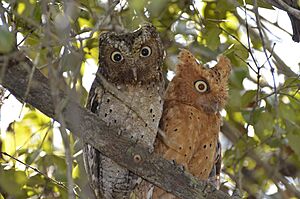Sokoke scops owl facts for kids
Quick facts for kids Sokoke scops owl |
|
|---|---|
 |
|
| Conservation status | |
| Scientific classification | |
| Genus: |
Otus
|
| Species: |
ireneae
|
The Sokoke scops owl (Otus ireneae) is a small owl that lives in only a few special lowland forests in Kenya and Tanzania. This means it's a very rare bird to find! Most of these owls live in a specific part of the Sokoke Forest in Kenya. They also live in other similar forest areas.
This tiny owl is the smallest of all scops owls. It can grow to about 17 centimeters (6.5 inches) tall and weigh around 57 grams (2 ounces). The Sokoke scops owl eats mostly insects. Its feathers can be different colors, from grey to a reddish-brown.
Contents
What Does the Sokoke Scops Owl Look Like?
The Sokoke scops owl is a simple-looking owl with small spots on its belly. These owls can have different feather colors. Some are grey, some are brown, and others are a reddish-orange. This is called having different "color morphs."
Their call sounds like a repeated "too-too-too-too-too." It can remind you of the calls made by tinkerbirds. Male owls have a louder, clearer, and higher-pitched call. Female owls have a softer, lower-pitched call. These owls are very protective of their space. Pairs might call together if another owl tries to enter their area. The owls call more or less depending on the time of night and how bright the moon is.
Where Do Sokoke Scops Owls Live?
Sokoke scops owls live in a very small area along the coast of Kenya and in northeastern Tanzania. They were first found in 1965 in the Arabuko-Sokoke Forest Reserve in Kenya. Later, two other groups of these owls were found. One group lives in the Dakatcha woodlands in Kenya. The other lives in the Manga and Kwamgumi forest reserves in Tanzania.
The total area where these owls live is not much bigger than 500 square kilometers (about 193 square miles). Scientists think there might be other small groups of these owls living in forests that haven't been explored yet.
What Kind of Home Do They Need?
Sokoke scops owls need very specific types of undisturbed lowland forest to live in. In the Arabuko-Sokoke Forest Reserve, they only live in forests with many Brachylaena and Cynometra trees. Even if there are other types of forests nearby, the owls prefer these special trees.
It's believed that holes in Brachylaena trees are perfect places for the owls to build their nests. If these trees are cut down, it could cause the owl population to shrink.
Protecting the Sokoke Scops Owl
The IUCN lists the Sokoke scops owl as an Endangered animal on its Red List. This means they are at high risk of disappearing forever. Because they need undisturbed forests, they are in danger from things like logging, fires, and people moving into their habitat.
Climate change is also a threat. Scientists predict that the suitable weather conditions for these owls will move south. This could mean they lose their homes in places like the Usambara mountains by the year 2080. Also, the small forest areas where they live are often surrounded by human-made areas. This makes it hard for the owls to move to new places if their home is damaged.
More African elephants in the Arabuko-Sokoke Forest Reserve might also harm the owls' homes. This is because elephants can change the forest by eating plants and trees. To help save these owls, people have suggested restoring their habitats. They also think about moving some owls to other safe forest areas. Surveys in 2005 and 2008 found about 800 pairs of owls in the Arabuko-Sokoke Forest Reserve. The population in the East Usambaras is much smaller.
How Do Sokoke Scops Owls Behave?
Like other Otus owls, Sokoke scops owls are strictly nocturnal. This means they are only active at night. This makes them hard to study! They are most active right after the sun sets and just before it rises. They also travel further from their resting spots to find food when the moon is not very bright.
During the day, they rest in the thick bushes of Cynometra trees. A pair of owls usually uses an area of about 11 hectares (about 27 acres) as their home. They don't usually share this space with other owl pairs.
What Do Sokoke Scops Owls Eat?
Scientists study owl pellets (regurgitated undigested food) to see what they eat. These studies show that Sokoke scops owls eat almost only medium-sized insects. They eat many different kinds of insects. The type of insect they eat most probably depends on what is available at the time. Beetles and crickets seem to be their favorite foods.
Images for kids




